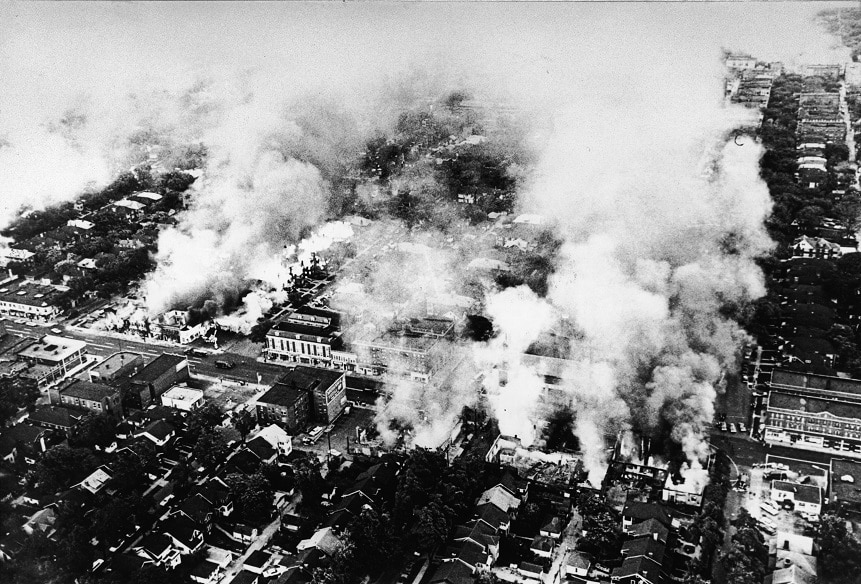
“I’m a native Detroiter, so this is a way to explain my history and my city. It’s an important landscape to me. It helped to shape the landscape we have now. I wanted to offer a human face to it for all of us – those of us who have lived there and those who have not.” Dominique Morriseau
With Detroit ’67, playwright Dominique Morisseau has written an exquisite story of determination and great disappointment. Set just a few days before the city’s most violent race riot erupts and ravages the city, the play captures the social upheaval and fraught racial tensions of the 1960s. It was a time of great change, hope, violence and disparity. The war waged in Vietnam and Motown could be heard on every street corner. The efforts of the Civil Rights Movements were met with increasing racism and police brutality.
In this play we meet Chelle and her brother Lank who are working hard to stay afloat during tough economic times. With the life insurance money from their father’s recent passing, the two decide to set up an after-hours joint in their basement. While Chelle is happy to work from their home, Lank has bigger plans in mind. He has his heart set on buying a club of his very own with his best friend Sly.
LANK I’m tired of bein’ laid off at that plant and runnin’ joints outta my basement like I got somethin’ to hide. Like the only way I can be somethin’ is underground. I’m ready to be above ground just like them White folks. Ain’t no tellin’ what Detroit could be if we was all put to good use. We could make some kinda … what’s that word when things is all copesthetic and beautiful? Like perfect, damn near?
SLY Utopia.
LANK Utopia. Detroit could be some kinda… what’s that place Malcolm went? Side by side with them other.. y’know… Muhammed folks?
SLY Mecca.
In addition to establishing a legitimate business of their own, Lank and Sly want a place where black men and women can go to unwind. As the two men set their sights on the American Dream, their city explodes in a wave of violence that threatens to erase everything they hold dear.

Race Relations in the U.S. in the 1960s
The mid-to-late 60s marked a change the social, racial and political landscape of the U.S.. With the Civil Rights Movement, the death of Malcolm X and Martin Luther King Jr., the Nation of Islam and the Black Power Movement, black men and women gained a sense of power and autonomy unlike any they had ever experienced.
The impact of racism on individuals and communities has blighted the history of the United States. While efforts to combat racism began during slavery with the abolitionist movement, it was the Civil Rights Movement that forever changed race relations in this country. The boycotts, sit-ins, protests and marches of the 50s and 60s led to the Civil Rights Act of 1964, which guaranteed equal access to all public accommodations, forbade discrimination in any state program receiving federal aid and outlawed discrimination in employment and voting. It was set into motion on June 19, 1963 by President John F. Kennedy:
-
• June 19, 1963 – President Kennedy submits bill H.R. 7152 to the House of Representatives.
• November 22, 1963 – Lee Harvey Oswald assassinates President John F. Kennedy.
• November 27, 1963 – President Lyndon B. Johnson, speaking before a Joint Session of Congress, says, “No memorial oration or eulogy could more eloquently honor President Kennedy’s memory than the earliest possible passage of the Civil Rights Bill for which he fought so long.”
• February 10, 1964 – The Civil Rights bill passes the House.
• March 30, 1964 – June 10, 1964 – The Senate debates the bill for 60 working days, including seven Saturdays with many attempts to filibuster the bill. The Senate Committee on the Judiciary is not involved.
• June 9-10, 1964 – Senator Robert C. Byrd of West Virginia filibusters the bill for 14 hours and 13 minutes before the Senate votes 71 to 29 to cloture the bill. This vote by two-thirds or more brings all debate to an end.
• June 19, 1964 – In a 73 to 27 vote, the Senate adopts an amended bill, which is sent back to the House.
• July 2, 1964 – The House of Representatives adopts the Senate version of the bill 289-126 and President Lyndon B. Johnson signs the bill into law.
Unfortunately, however, the passing of the Civil Rights Act of 1964, the Voting Rights Act of 1965 and the 1968 Fair Housing Act was not enough to curb discriminatory practices or racist attitudes. Civil Rights leaders and activists of all races who traveled to the South to contest segregation laws and practices were met by angry mobs and police brutality. They were verbally assaulted, beaten and even killed. An already tense situation was ignited and the nation erupted.
From 1964 to 1968, race riots broke out in major cities across the United States, including Los Angeles, New Jersey, Chicago and Philadelphia. In response to the riots, police were called in to restore peace, and they used excessive force to do so. Men and women were beaten with clubs, attacked by police dogs and had fire hoses turned on them. All of this played on television and was reported in the newspapers.
Click here for Part II of Jacqueline’s exploration of Detroit ’67.
Join us for this riveting new play inspired by an explosive moment in American history, onstage Sep 14 – Oct 2
Click here for tickets or call 919.962.7529.